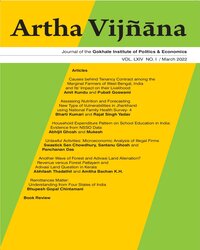Understanding Dynamics of Inflation through P-Star Approach:A Study of Post-Independence India
Subscribe/Renew Journal
This paper tries to understand the dynamics of inflation of India through the lens of P-star approach for the period 1952-1953 to 2013-2014. The equilibrium values for the relevant variables are estimated using two versions of Hodrick-Prescott (HP) filter. Three different types of models have been tested following the P-star approach- Price Gap Model, Output Gap Model and Velocity Gap Model. The study finds satisfactory fit for all models, as all of them reveal expected signs with statistically significant coefficients for the output gap and velocity gap variables. However, forecasting performance shows Output Gap Model as the most appropriate model in understanding inflation in India.
Subscription
Login to verify subscription
User
Font Size
Information



